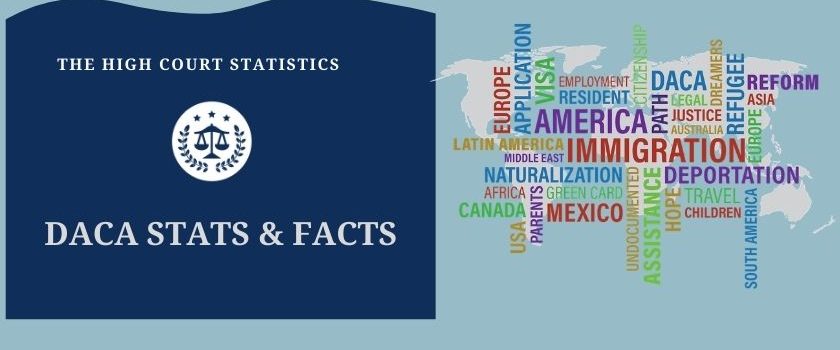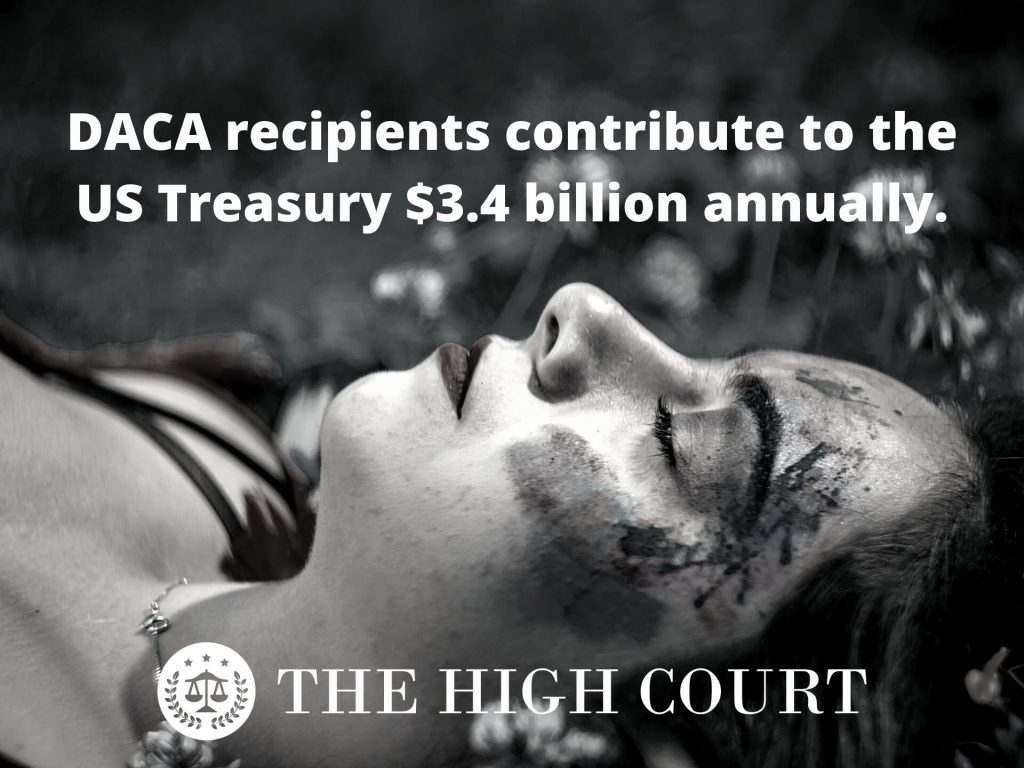
Before checking out the top DACA facts, we thought we should go over the basics of what DACA really means.
So, what is DACA all about?
Here’s the deal:
Deferred Action for Childhood Arrivals or DACA allows some individuals who have been brought to the US illegally when they were children to get a two-year period of postponed action from deportation. Within that period, they can get their legal documentation and remain in the country. It also offers them a chance to be eligible for a work permit.
The DACA act was introduced in 2012 by President Obama as a way to offer individuals some kind of protection from deportation and a DACA path to citizenship.
The question is:
Who is eligible for the DACA program?
Basically, anyone who doesn’t have any felonies or serious misdemeanors in their portfolio falls into the DACA criteria. However, all applicants have to go through extensive background checks and renew their application every two years if they wish to remain in the program.
Now:
Do you want to know more DACA info? Check out all about the DACA requirements and learn some fun facts about immigration we’ve curated for you at The High Court!
Insightful DACA Statistics (Editor’s Picks)
- 7% of DACA requests between 2012 and March 2020 were rejected.
- 80% of the Dreamers (517,460) originate from Mexico.
- 12.41% of DACA beneficiaries live in the greater Los Angeles area.
- The spending power of DACA recipients and their households accounts for $24.1 billion.
- The cost of physically removing DACA recipients would be between $7 billion and $21 billion.
- DACA recipients can be issued driver’s licenses in all 50 US states.
- Between August 1, 2019, and August 1, 2020, around 96% of DACA renewal requests processed were completed in 120 or days or less.
General DACA Facts and Stats
1. The Homeland Security Digital Library (HSDL) issued the press release for DACA on June 15, 2012.
(Source: HSDL)
The DACA program was created because most children who entered the US illegally with their parents were escaping poverty and looking to provide a better life for themselves and their families. The Homeland Security Digital Library (HSDL) issued the press release on June 15, 2012.
At that time, the Secretary of Homeland Security, Janet Napolitano, announced the new policy. This is how DACA legality was established, and the truth about DACA and Dreamers started.
2. Between 2012 and March 2020, around 825,998 people got approved to participate in the DACA program, DACA recipients statistics reveal.
(Source: USA Facts)
In fact, the largest number of individuals – 472,287 – got approved in the first two years after opening the program. In recent years, there has been a significant reduction in the number of approvals. For instance, in 2018 and 2019, only 26,173 applicants were approved.
3. Since 2012, DACA has received two million renewal requests.
(Source: USA Facts)
According to the facts on DACA, DACA status lasts for two years at a time. This DACA executive order lasted until 2020. Naturally, not everyone who applies for renewal is approved. Statistics show that between 2012 and March 2020, the USCIS has rejected 7% of requests. In numbers, the rejected requests are precisely 148,304.
4. In April 2020, nearly 700,000 young people were DACA recipients.
(Source: FWD, MPI)
In 2018, MPI reported estimates of 1.3 million eligible DACA recipients who met all the criteria.
What’s more:
MPI estimated another 408,000 prospective eligible applicants (if they meet educational requirements). Additionally, another 120,000 will be eligible DREAMers when they turn 15 and stay in the educational system.
Dreamers Facts and Stats
5. Dreamer statistics show the majority of DACA recipients are 26 years old on average.
(Source: SelfLawyer)
A recent report on the DACA program published by SelfLawyer includes an empirical portrait of US immigration policy and trend analysis. It explains policies fundamental to the process of immigration and forecasts.
The report provides valuable insight into who the beneficiaries are. DACA age, on average, included beneficiaries who are 26 years old or range between the ages of 22 and 29.
6. Out of 3,000 survey respondents, the majority of DACA recipients were under six years old when they arrived in the US.
(Source: SelfLawyer)
In regards to the average age of Dreamers at the time of entry in the US data sourced from an online survey and included in the SelfLawyer report reveals that the majority were under the age of six when they arrived in the US. The largest group percentage-wise were three-year-olds (9.7%) at the time they entered the US.
7. All DACA recipients have lived in the US for ten years or more.
(Source: FWD.us)
The aim of the DACA program is to protect immigrants from being deported. Meanwhile, the program doesn’t affect the immigrants’ status or the path to becoming a naturalized US citizen or lawful permanent resident.
While all DACA recipients have lived in the US for a decade, many have lived even longer. DACA beneficiaries have been educated in American schools, and many have obtained degrees from US universities. Except on paper, the so-called Dreamers are American in every other way.
8. In March 2020, 53% of the DACA recipients were female, while 47% were males.
(Source: USA Facts)
Some of the most recent Dreamers statistics show that females have received a slightly higher number of approvals. While the average age of Dreamers is 26, About 37% of active DACA recipients are between 21 and 25. In 2020, only 70 Dreamers were under younger than 16.
9. The latest DACA statistics show most Dreamers – 80% – were born in Mexico.
(Source: USA Facts)
According to the latest DACA statistics by state, exactly 517,460 DACA recipients originate from Mexico. Most of the others come from Central America: 3% are from Guatemala, 4% are from El Salvador. A smaller number come from South Korea – 0.9% or exactly 6,210 individuals.
Now:
Since most other countries have fewer than ten active Dreamers in the programs, they aren’t reported by the USCIS. Some of those countries are Kosovo, Niger, Switzerland, Algeria, and Azerbaijan.
10. 45% of DACA recipients live in California (183,460) and Texas (106,090).
(Source: USA Facts)
The state that follows the leading two, California and Texas, is Illinois, where 5% or 33,940 individuals live. The state that ranks the lowest is Vermont, with 20 recipients. In terms of all American territories, Guam is ranked even lower than Vermont, with only 10 DACA recipients.
11. Approximately 12.41% of DACA beneficiaries live in the greater Los Angeles area.
(Source: SelfLawyer)
According to the latest statistics on DACA, the second most populated city area with DACA recipients after Los Angeles is New York, with 6.44%. Third is the Dallas area with 5.39%.
12. DACA recipients are parents to 256,000 US-born children.
(Source: SelfLawyer, AP)
Immigration facts and statistics reveal 75.51% of DACA recipients are single, 22.5% are married, and 1.59% are divorced. Today, nearly 256,000 US-born children have at least one parent who is a DACA recipient.
What’s more:
[bctt tweet=”1.5 million individuals live with a DACA recipient.” via=”no”]
——————————————————————————————————————————————————-
Economic and Fiscal Impact DACA Statistics
13. The combined spending power of DACA recipients and their households is $24.1 billion.
(Source: FWD.us)
Recent DACA facts suggest many DACA recipients are living in uncertainty and fear between each court case. FWD points out the necessity of a permanent legislative solution provided by Congress so that hundreds of thousands of people can remain with their families, loved ones, and communities.
[bctt tweet=”Besides the devastating impact on the lives of the DACA recipients, statistics on Dreamers show that inaction will hurt the US economy.” via=”no”]
14. DACA recipients contribute to the US Treasury $3.4 billion annually.
(Source: American Action Forum)
Dreamer statistics suggest that removing DACA recipients will reduce overall GDP by approximately $42 billion and cause a net loss to the federal government of $3.4 billion.
15. The cost of physically removing DACA recipients would be between $7 billion and $21 billion.
(Source: American Action Forum)
Deportation facts show the immense amount of money the government would have to spend if it decides to get rid of the Dreamers – anywhere between $7 billion and $21 billion.
In addition, this will reduce GDP by 0.4%. The cost of removing all DACA-eligible immigrants would be between $18 billion and $52 billion. Also, it would reduce GDP by $72 billion (1%).
16. DACA recipients can be issued driver’s licenses in all 50 US states.
(Source: CAP)
Facts about Dreamers show that DACA recipients can be issued driver’s licenses across the US. Additionally, at least 19 states have passed laws to provide DACA recipients with the possibility to receive in-state tuition. Finally, 13 states extend certain professional licenses to undocumented immigrants.
Such licenses are required to worth in some industries (like medicine, cosmetology, or education).
17. 60% of Dreamers have purchased a vehicle.
(Source: FWD.us)
DACA employment statistics reveal Dreamers contribute about $2 billion to Social Security and $470 million to Medicare every year. Estimates suggest that, over a decade, approximately $1 trillion will be added to national GDP if permanent protections for DACA recipients are passed.
And that’s not all:
[bctt tweet=”14% of Dreamers own homes and pay around $380 million in property taxes every year.” via=”no”]
Finally, 96% of them are either working or in school, while 6% have started businesses and employ other Americans.
DACA Legal Facts
18. Chief Justice John Roberts decided that the Trump administration failed to provide a reasoned explanation for ending DACA after a 5-4 Supreme Court decision in June 2020.
(Source: National Immigrant Forum)
Although President Trump sought to end DACA starting in 2017, on June 18, 2020, the Supreme Court allowed DACA recipients to regain the DACA benefits. There were a lot of discussions regarding the question of why DACA should stay.
However:
The Supreme Court upheld the executive action of President Obama. Chief Justice John Roberts decided that the Trump administration had failed to provide a reasoned explanation for ending the program.
19. From August 1, 2019, to August 1, 2020, around 96% of DACA renewal requests processed were completed in 120 or fewer days.
(Source: USCIS)
This is an interesting fact about immigration programs that are efficiently handled. With the new decision of the Supreme Court, a policy memorandum came along in August 2020.
One of the directed actions included in the memorandum was that all DACA applications submitted prior to 150 days before the expiration date should be rejected by USCIS.
Regardless of the large number of renewal cases, though, all were processed in good time. So, there was no need for such time-advanced submission.
20. From 2020 on, DACA recipients must renew every year to maintain its protections.
(Source: USCIS)
Previously, DACA was renewable every two years. Following the July 2020 Wolf memorandum that supports DACA legislation, recipients must renew every year to maintain the program protections.
Now:
One of the DACA myths is that families that arrive now may be eligible for such status. However, this is simply not true. None of the people entering the US illegally today are eligible to apply for DACA or any visa.
21. 52% of US adults support the Supreme Court’s ruling on DACA.
(Source: Statista)
The June 2020 stats show that just over half of US adults either somewhat or strongly support the Supreme Court’s ruling that the termination of the DACA program by Trump was unlawful.
22. 65% of Hispanic respondents support the supreme court’s ruling on DACA.
(Source: Statista)
When it comes to approval ratings to the Supreme Court ruling by ethnicity:
67% of African-American and 65% of Hispanic respondents either strongly or somewhat support the ruling that Trump’s termination of the DACA program was unlawful.
In contrast, only 47% of white respondents stated the same. At the same time, 22% of white respondents strongly disapprove of this statement.
Wrap Up
Based on the latest DACA information and DACA facts, we can safely say the importance of the program goes beyond just numbers.
The thing is:
DACA recipients have homes, families, friends, and their whole lives in the US. So, the deportation process would not be just inhumane – it will also cost the country billions of dollars.
Also, this isn’t just due to ethical reasons. In fact, Dreamers actually play an integral part in the US economy. They form a significant chunk of consumers and spenders that are vital for sales.
Even though there have been various conflicts concerning the future of the young Dreamers, the rights of the DACA kids have been preserved. There is even a movement called Defend DACA that will further fight for the rights of such individuals.
We hope that the DACA facts presented above have brought the critical matter of this group of immigrants closer to you.
——————————————————————————————————————————————————-
FAQ
Q: Who created the Dream Act?
The Dream Act was created by Dick Durbin (D-Illinois) and Orrin Hatch (R-Utah) in 2001, with the purpose of creating a process by which immigrants would be able to apply for conditional residency. This would later be followed by permanent residency in accordance with the age at which they entered the US.
One of the most interesting facts about immigration is that the term dreamers comes from the acronym of the D.R.E.A.M. Act. Originally introduced in 2001, though it didn’t pass at the time, the Development, Relief, and Education for Alien Minors Act acronym DREAM is used for addressing DACA beneficiaries as dreamers.
DACA beneficiaries, also known as Dreamers, qualify for in-state college tuition and state-funded educational loans and grants. Besides, they may also be eligible for state-subsidized health insurance depending on where they live. In addition to the DACA and the Dream Act, there are other policies designed to protect dreamers.
Q: What does deferred action mean?
According to the United States Citizenship and Immigration Services (USCIS), deferred action is the action defined as discretionary determination to defer the deportation of a person as an act of prosecutorial discretion. The deferred action is granted either by a federal immigration judge or the USCIS. The two actions on immigration are the Deferred Action for Childhood Arrivals (DACA) and the new Deferred Action for Parents of Americans and Lawful Permanent Residents (DAPA).
Q: How many DACA recipients are there?
According to 2018 DACA statistics, the number of DACA recipients who reside in the United States equals 699,350. However, since the DACA program was launched in 2012, 826,000 people have been accepted into the program.
Q: Why is DACA important?
DACA is important because it’s good for the US economy. Facts about DACA recipients show that they will add around $460.3 billion to the US economy. So, there are several reasons to keep DACA ongoing. The cruel and inhumane deportation of Dreamer children will result in a reduced spending capacity for the US, fewer customers, and also fewer sales. Also, many citizens and residents will be on the verge of losing their jobs because of the fewer dollars that will be spent in the country, DACA facts confirm.
——————————————————————————————————————————————————-
Sources:




